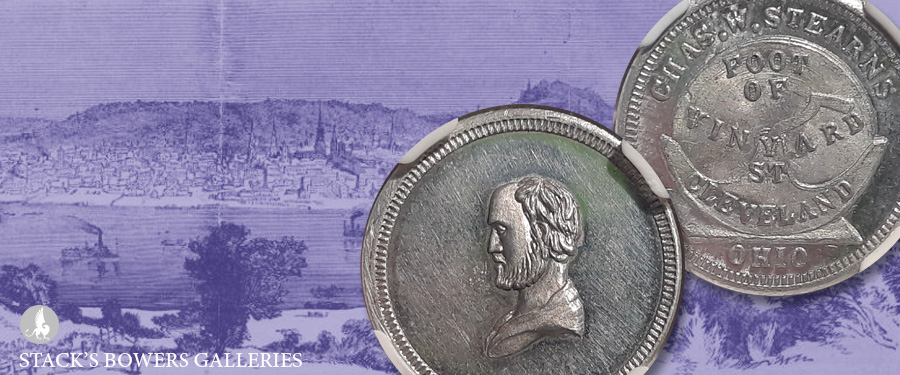
Civil War tokens exist in numerous compositions, metallic and otherwise. Various tokens of silver, bronze, copper, white metal, zinc, lead, and rubber are known, but only one is found in aluminum, a metal that only entered widespread use for coins and tokens later in the 19th century. Cataloged as OH175O-4r, the token was struck with an obverse die commissioned by a Cleveland grindstone and building stone firm (also seen on other tokens) and a reverse die sporting an enigmatic portrait that was only used to produce a handful of other Civil War tokens. (Token image courtesy of John Ostendorf.)
John Stanton or James Murdock, Jr. may have been the die sinker responsible for this distinctive piece. The former, a prominent Cincinnati die sinker, employed the latter, an Irish-born artisan whose occupation was listed in an 1860 Cincinnati directory as “stamp cutter” per a very helpful 2018 Numismatist article by David Schenkman. The Stanton shop, which in this period included the talents of the above mentioned Stanton and Murdock, as well as William Spencer, produced more Civil War tokens than any other firm in the country (again per Schenkman). In addition to business strikes, numismatic pieces were produced by various die sinkers for different clients; OH175O-4r falls into this category.
The circumstances surrounding the aluminum token’s production are murky. It may have been produced while Stanton still owned the diesinking firm or shortly after its sale to Murdock and Spencer. In the fall 2022 edition of Civil War Era Numismatics, the journal of the Civil War Token Society, John Ostendorf, author of the book Civil War Store Cards of Cincinnati, writes that the aluminum token “must have been for a very special client or [struck] as a personal keepsake.” Ostendorf further points out that Stanton’s firm produced many numismatic strikes late in the Civil War and that the firm continued producing numismatic strikes after Murdock and Spencer bought the firm from Stanton in 1864. Ostendorf writes that the high-water mark for numismatic strikes of Civil War tokens was in the conflict’s waning months and its immediate aftermath. Moreover, aluminum was regarded as a near-precious metal in the 1860s – it would not be used to strike coins and tokens until later.
The obverse die, cataloged as 35210, was commissioned by Charles W. Stearns, a Cleveland-based building stone merchant. Stearns’ name arcs along the top of the obverse, “OHIO” along the bottom. “FOOT OF VINEYARD ST. CLEVELAND” is set against a grindstone, one of the main products produced by the firm; another reverse die more commonly paired with this obverse describes Stearns’ business as “GRINDSTONES FLAGGING & BUILDING STONES.” Tokens with this latter die pairing are relatively common.
The reverse die, cataloged as 1160, features the portrait of an unidentified man. Civil War token experts long thought that the portrait was Stanton’s, though Ostendorf suggests it could be Murdock, Stearns, or Cincinnatus. This die was paired with a handful of others for numismatic strikes.
OH175O-4r is unique, with one example known.





